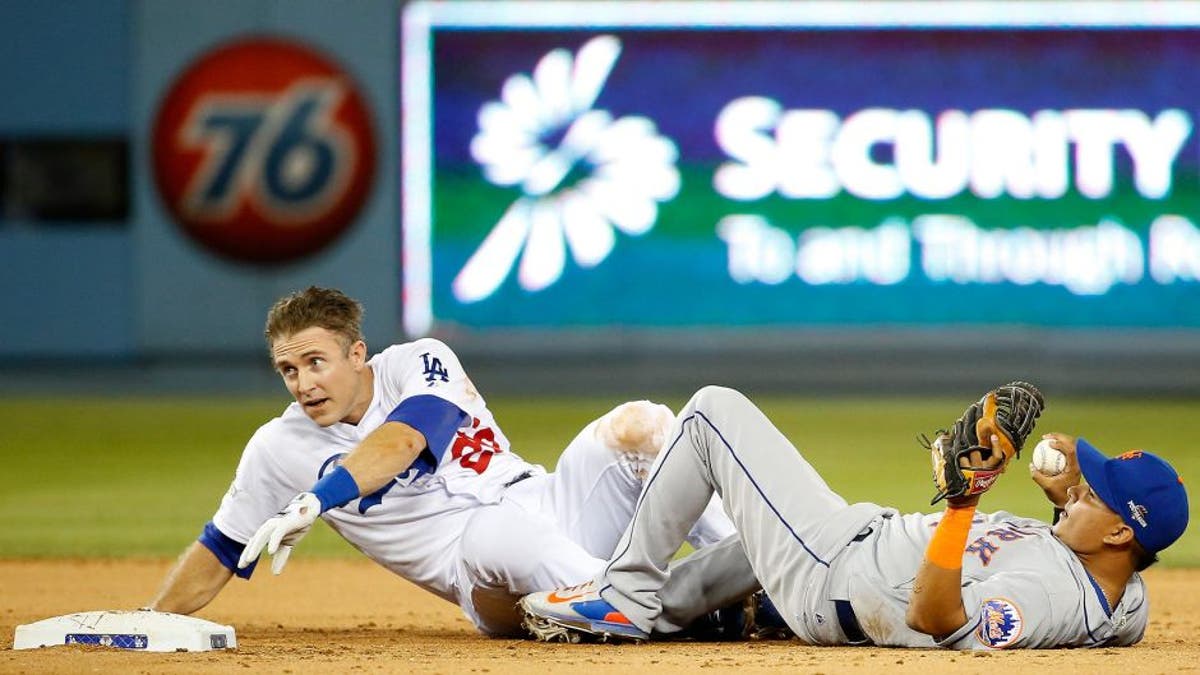
The new rule to protect middle infielders cannot be written quickly enough. I'm not exactly sure what it should say, but the sooner it happens, the sooner baseball can stop making up the rest as it goes along.
In a vacuum, I've got no problem with baseball suspending the Dodgers' Chase Utley for his so-called slide into the Mets shortstop Ruben Tejada -- Utley went in too high and too late. Alas, such decisions do not occur in a vacuum.
Most suspensions are based on precedent; the consistency here is lacking. Yes, the Yankees' Shelley Duncan received a three-game suspension for a high slide during spring training in 2008. But over the years we've seen countless dangerous takeouts at second base that did not prompt discipline -- by Mets players, by other players, by Utley himself.
Would Utley have been suspended if he had not broken Tejada's fibula? Would Utley have been suspended if the game had taken place in April and not October? Why is baseball suddenly enforcing Rule 5.09(a)(13), which is designed to protect fielders from a rolling block that occurs away from the base, when the sport rarely has before?
I posed that very question Sunday night to Joe Torre, MLB's chief baseball officer and author of the Utley decision, during our FS1 broadcast of Game 3 of the Blue Jays-Rangers Division Series.
"I can't worry about what's happened in the past," Torre replied. "I just based it on what I saw. And we're trying to have rules that are going to keep these players on the field."
Fair enough -- that should be the idea, just as it was when baseball implemented the Buster Posey rule to protect catchers from egregious home-plate collisions, a rule that has worked to great effect.
Still, I expect Utley's suspension to be reduced to one game, or overturned entirely, due to the lack of sufficient precedent. And even on this play -- a play in which Utley went too far -- there were mitigating circumstances.
One of the most fair-minded players I know reached out to me Sunday to discuss the subject. I will share his thoughts without revealing his name; his balanced perspective is more important than his identity.
Here is what the player said:
"In any sport when you put a replay in slow motion, viewers/analysts think athletes are weighing thoughts and pros/cons because it looks slow.
"We play on instincts and react to situations. We know with one out and first-and-third in double-play situations, we have to try and break up the play.
"We don't take into account the possibility of a bad throw or a middle infielder being in an awkward position." The play occurred with runners at first and third, one out in the bottom of the seventh inning and the Dodgers trailing Game 2 of the Division Series, 2-1. The tying run scored, and the Dodgers went on to a 5-2 victory.
A number of past and current players have mentioned to me that second baseman Daniel Murphy's soft toss and Tejada's turning of his back to Utley contributed to the outcome. Those players are not blaming Tejada and exonerating Utley; they are simply pointing out that the play was more complicated than it appeared.
"In a regular-season game, Tejada likely catches the ball and takes the one out, but he knows the situation as does Chase who probably (but maybe not because he plays only one way) slides differently," the fair-minded veteran said. "Both guys know the series is essentially on the line there and want to make a winning play."
Alas, the play disintegrated like a car crash and Tejada suffered an injury that could jeopardize his career. The Pirates' Jung Ho-Kang met a similar fate on Sept. 17, suffering a torn MCL and fractured tibia on a takeout slide by the Cubs' Chris Coghlan, who was not disciplined.
Yes, occasional contact is inevitable and part of the game, but when two playoff teams lose starting infielders within a matter of weeks, something is wrong. The good news is that baseball finally plans to act on the problem. Torre mentioned in his statement on Utley that the sport intends to continue talks with the union this offseason about a new rule to better protect middle infielders.
What would such a rule look like? Torre said on our broadcast that his preference is for runners to slide directly into the base rather than at an infielder, an adjustment currently being tested in the Arizona Fall League. Some players likely will oppose that change, believing it to be too drastic.
One suggested eliminating late slides, saying runners should be required to hit the dirt first, then slide through -- something Utley did not do. Another said that baseball needs to expand the scope of the neighborhood play so that infielders can get out of the way without worrying about touching the bag -- perhaps that would have helped Tejada.
As we've learned with replay, things are rarely as simple as they seem. Baseball needed to adjust the home-plate collision rule so that umpires would not apply it on force plays at the plate. A rule to protect middle infielders will require careful study, and adjustment will be necessary if unintended consequences occur.
All that is understood; just get on with it already. The umpires' interpretation of the rules Saturday, combined with Torre's decision Sunday, created a legal mess to rival the physical mess that occurred when Utley barreled into Tejada. And that's saying something.
